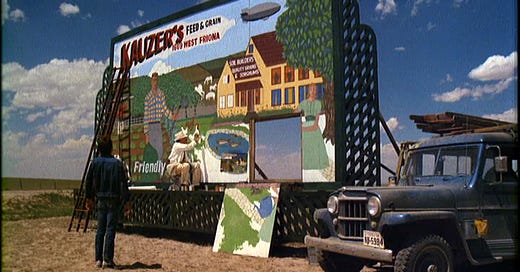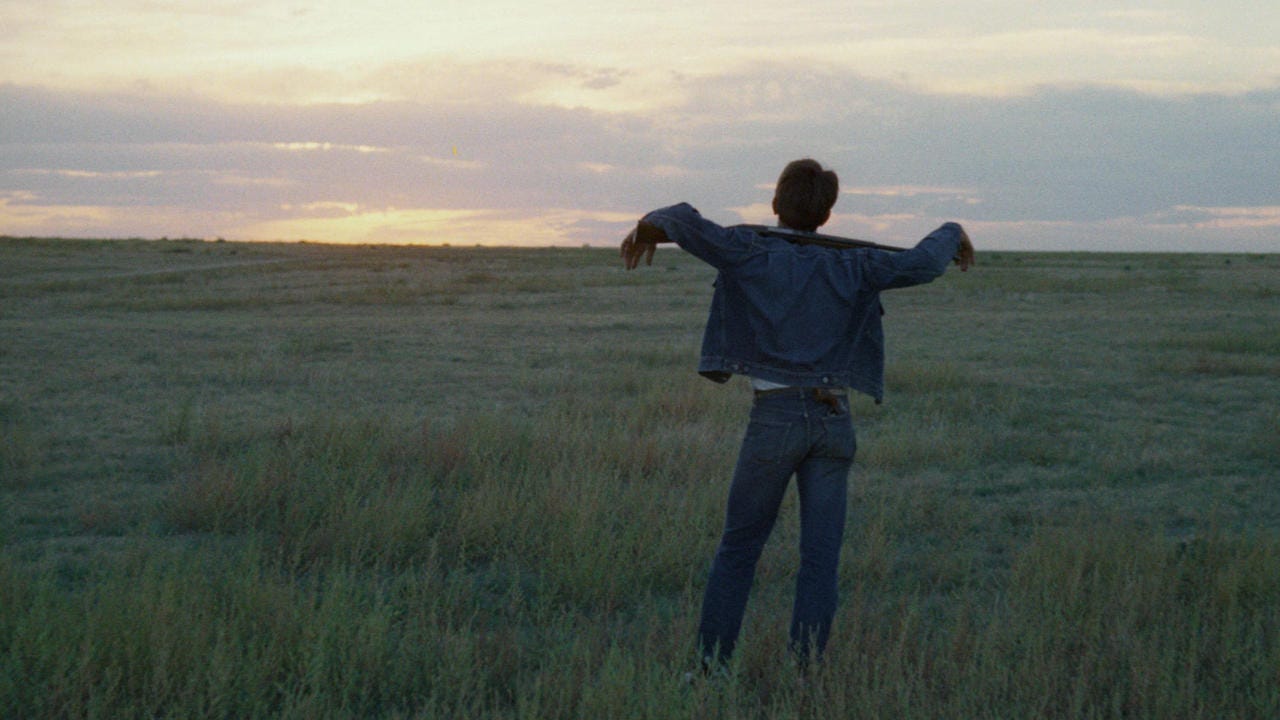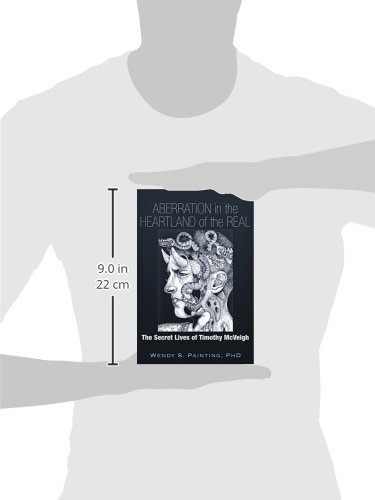A Faraway Planet To Which I Would Never Return
The vanishing horizon line of Terrence Malick's BADLANDS
Discoursing upon that which showed itself in itself of Charles Starkweather and his adolescent bride Caril Ann Fugate while remorsing upon his brother’s suicide, Malick’s debut proclaims what’s been lost, who’s been left behind, and what we might attempt restrained by what we’re allowed to be.
Kit is a trash collector by trade, Batailling against the solar surpluses reclaimable in the culturubble, throwing away items of no-to-low utility[1], revealing how even The Outsider can only seek emancipation from materialism in refuse materials, much as turning one’s back on the they involves turning one’s back in the way the they have always turned their backs.
A character of never dwelling anywhere, curiosity is everywhere and nowhere for Kit, whose horizon is informed by the seem outlaw possibilities the filmic frame presents those of us Landlocked out of the American scheme. Now alienated from dreaming even our own dreams, our horizon is the rearward-leaking retrochronic echo wave of a celluloid reference point from still-real 1973.
If this is tragicomic, it is the tragedy of every distance not neared and the comedy of separation signified by the apophantical ‘as,’ as even Shakespeare’s circumcentral question “To be or not to be?” has been made meaningless as the words “Know Thyself” appearing on every toilet calendar[2].
If this is merely idle worship, then maybe our post-ontological preoccupation with technēseins makes us like Holly, like young Women in Love, choosing the horizon of the most “trigger happy person” we’ve ever known as our own.
If this is heroic, then Kit and your programmers are Quixotic heroes at beast, oft burdened by Holly’s knowing, “The world was like a faraway planet to which I could never return.”
When his doctoral thesis on the concept of world in Heidegger, Kierkegaard, and Wittgenstein was rejected by Gilberte Ryle, Terrence Malick, already triumphant over the universal bias against those resembling Gomer Pyle, attended the selfseim American Film Institute gestational of David Lynch’s squabhood anxiety and the Quentin Tarantino quipidemic that neither “pleases through its form” or “serves as a means to the beautiful” yet still we Kant stop Marvelling at. For Heidegger, the horizon was the windbreak and boundary line of our evolving and involuting personal and interpersonal worldly understandings, “the range of all that can be seen from a particular vantage point” that “encompasses both what is visible and what is not” by defining “the limits of our perception.[3]”
For audiences of BADLANDS, the horizon is the edge of the cinematic frame. Yet for the bathroom break-away civilization in the intermissionary lines at the Tarkovsky time-sculpture, just moments after our pupils are ever-briefly dilated to the concupiscent lightning look, after our ears are attenuated to the birding cry, we’re tolled to re-align our senses and Pound back the postmodernly bettered popcorn under cruel fluorescent lights, toiled to prefer our effervescent Sprites to the vanishing horizon line of manifest destiny’s rebel yell.
Knee Play #1: “Eyes Like Silk In The Missionary Times”
Hither and thither go The They,
asking, “How ’bout that proximal weather today?”
desevering the right to wither away
in the referential totality, intuited formally
unless, if/else, a posteriori?
Participling as phosphorus particles
in the participation mystique
of a ‘world’ at any time
we have to wander a why
we’re never here but yonder.
So too does Holly’s father Glass over the primordial by painting a billboard of farm land fresh and clean as Einstein on the Beach’s narratological vice aching to get some wind for the sailboat as appeased to waiting on some wind for the sailboat.
As he McVeighs the colour scheme of his Aberration in the Heartland of the Real, farmland lies in the passive tension of the eternally ready-at-hand. Through an open panel in the simulacrum, by camera obscura, in the geistation of the crosscut March of Time, Malick creates a clearing for the earth neglected by the lusty eye, yet still entwined with mortals, air, and sky.
Like Shakespeare’s own centrifugal question subsumed-into Looney Tunes, Kit stands in the space before the whole where he’s ever-briefly DER LETZTE MANN to occupy the real and the virtual quite so same lessly.
Bergson believed the virtual to be the continuous realm of possibility and imagination that contains all possibilities, thus relegating the real to the enduring (if tiresome) realm of repetitive action and actuality. There’s even the Deleuzion that the virtual not only immanentizes the actual world, but is more real than it. In the reel of film, however, Malick, a man called to abandon the mystic weird games of wordly philosophy, inoculates against the Virulent Nihilism of virtuality with a whole-y sign that reconceals these ideas under the Matter and Memory foam mattress where they belong.
To do so, a virtuoso must shoot in 35mm to regard ontically and factically that […] which is first and closest to us. So too must Kit shoot Holly’s father with his 22mm Sentinel Revolver to resist being kept under Locke and Keynes. Taking Measure for Measure, we should be so feral as to kill the quip-shit inanition in the hauntelegiacal prophet models of ANT-MAN 11: ANTS IN MY ELLA ENCHANTS that Pangloss over the living inheritance of our cinematic memory.
But “What to do?” wonders DJ Spooky, “How to get there?” Where to find the metacreative saving power constricted by the technêxponential crunch of frame-rate compression that numbs The Famer in the City on the ruin from algorithms enframing us in an affliction from After the Law.
A manhunt ensues for young criminals who are “only tiles detached from a roof by the wind, falling randomly.[5]” Kit’s mercantile approach is to treat his pistol like a magic wand for getting what he wants. This posturing is futile as Gilbert Ryle’s penisolate war in the natural world. When he can’t catch fish with a net, he relies on this artefact of untamed Western Lands used only as a control mechanism by Kip’s commodified time, a time so wieldly-uncommodified compeered to our contemporary time. Turns out you cannot shoot technocapital like you were in a GUNFIGHT AT THE O.K. CORRAL, you can only be incorporated into it with a Carpe diem and desist ardour. All Kit can do is attempt. And even attempting prompts us towards temptation[4], as every young summer of love gives rise to the ANGELS AND DEMONS stomping skulls at Altamont, a speedway that commodifies the progress accident while offering not the least concrete Shelter From The Storm.
As Kit is framed in a fashion where his outstretched arms are even with the horizon, we’re outstretching our harms in Kit’s rebellious fusion. As Novalis knew that, “Philosophy is really a homesickness, an urge to be at home everywhere,” the movies are a pained sigh for the world we can’t quaint grow on a painted sign. And so like Bob Dylan learning to every moment face his death, we’re still looking to the titles of Gregory Pecktures that await the narrator of Brownsville Girl in uncertain states, still looking to westerns like THE BIG COUNTRY rather than to Westworld for a home outside the carceral quantum computational mind scrape to come. If even the most deluded outlaw can be as noble as our best inventions, then our intention is to test our Mettler by preserving what we can of film, that last loan ontological system available to all after the death of God now that we’re at THE END OF TIME again.
Our posthuman memory ever AIÔN FLUX, identities converged and submerged, lossiness less about absence than cessation, the disorientation of prolongation ever prescient, the worldhood of the world out of reach as an unfamiliar memory, there remains a nagging circumspection that this will “not be put back, not be made right again[5]” that what’s lost is gone, and yet we find ourselves still Pressing On as ghosts haunting our old home, for if cinema is wiped and banned by ideodigital storm, “if it’s impossible to see it” let alone essay it, “those of us who love the movies” must makes its most important truths the most well hidden, while still (as LA JETEE comprises la projeté) Weil continué to proselytize THE STORY OF FILM, “of the people who made them, of the places they were made, the objects that appeared in them, even the places where the great filmmakers sat and thought.[6]” In this giant battle for being, in this war at the heart of nature, we are eliding the virtual by siding with Terry Malick, still Rolling and Tumblin’ and dancing to vinyl on another Sudbury Saturday Night, still seeking our little girl’s lost home, still looking for our lost brother, still keeping track to the trace of the holy, still paying attention to what’s present everywhere even as it begins to disappear.
[1] Seth Binstead, Halkyon Academy Being and Time Seminar
[2] Johannes Niederhauser, Halkyon Academy Being and Time Seminar
[3] Martin Heidegger, The Question Concerning Technology
[4] Dr. Jack, Halkyon Academy Being and Time Seminar
[5] Simone Weil, The Love of God and Affliction
[6] Cormac McCarthy, The Road
[7] Mark Cousins, The Story of Film
[8] Bolded Words are from Heidegger’s Being and Time
[9] French words look like this.







You misspelled my last name, it’s Binsted